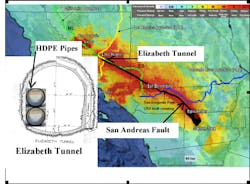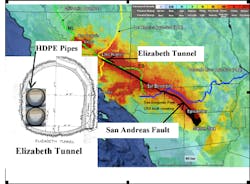Earthquake-resilient pipeline to keep water flowing to Los Angeles
March 12, 2013 -- Underground pipelines are lifelines when disaster strikes, especially in earthquakes. Now, researchers have discovered how to make water lines that will bend and move rather than snap and rupture in an earthquake.
The proving ground was Christchurch, New Zealand. The findings are now about to benefit Southern California.
Thomas O'Rourke, a professor at Cornell University, has found that medium- and high-density polyethylene pipelines (MDPE and HDPE) survive even when the earth liquefies and shifts. He and his colleagues at Cornell and Rensselaer Polytechnic Institute proved it using a mega-lab at Cornell and the centrifuge at RPI, all part of the George E. Brown Jr. Network for Earthquake Engineering Simulation (NEES). The next, harder part was convincing government leaders to try it.
It wasn't an easy sell at first, even though the materials -- basically plastic -- are relatively inexpensive. In Christchurch, which suffered a series of devastating earthquakes in 2010-2011, government leaders hedged and installed just 2.5 kilometers of polyethylene pipe and used more conventional pipe for the rest of the repairs. When two earthquakes hit, displacing two to three meters of earth, the standard segmental pipelines were destroyed, but all of the polyethylene conduits held.
Polyethylene pipelines are made by thermo-welding lengths of pipe together to form a continuous pipeline. Segmental pipelines have couplings or joints. The pipe at the joints is often not restrained from pullout under tension. The joints are generally weaker in bending and tension than a continuous pipeline of the same material.
Professor Thomas O'Rourke
"It was stunning," O'Rourke said. "Lateral spreading and settlements exceeded two meters for the segmental pipelines, but they didn't have to replace or repair the polyethylene pipes."
Building on NEES test results and the favorable Christchurch pipeline performance, Los Angeles engineers are preparing to install HDPE pipelines in the Elizabeth Tunnel, which carries Los Angeles aqueduct water across the San Andreas Fault, providing half of LA's water supply. It will significantly increase the likelihood that the water -- the most important resource after an earthquake -- will be available to 4 million people.
The tunnel is approximately three meters wide, and water moves by gravity flow. The new pipes will provide an auxiliary water supply, conveying water even when the tunnel is virtually cut off or collapsed. Pumps can be added to increase flow.
The $4 million to $5 million project is expected to begin this fall and be completed in phases over the next four to eight years. More than 2.5 miles of the 30-foot diameter pipeline will be installed about 2,000 feet at a time, necessitating about a one-month shutdown each time, says Craig Davis, geotechnical engineering manager for the Los Angeles Department of Water and Power.
The groundbreaking research was performed at NEES@Cornell's Large-Scale Lifelines Testing Facility, a world-class resource focused on underground lifelines -- water, sewage, oil, gas, electrical, etc. The pipeline research, performed with Professor Harry Stewart at Cornell, involved large-scale tests with more than 90 metric tons of partially saturated sand per test and 1.2 meters of strike-slip displacement, making them the largest ever preformed in an experimental facility.
At NEES@Rensselaer the research was performed with professors O'Rourke, Tarek Abdoun and Michael Symans. The team tested physical models of underground pipelines at fault crossings, using a unique split-box device. The RPI centrifuge uses a specialized shake table -- one of only three in existence -- that simulates earthquakes while the centrifuge is spinning.
Utility lines under Wall Street, 1917
The two sites are part of NEES's network of 14 laboratories across the country funded by the National Science Foundation and connected by state-of-the-art cyberinfrastructure developed at Purdue University.
A member of the National Academy of Engineering, O'Rourke has served on numerous earthquake reconnaissance missions across the globe. At public presentations about large systems, some of his hallmark slides show the spaghetti bowl of pipes and utility lines under Wall Street in New York City.
What you can't see underground -- the systems for water, sewers and gas -- are key to both preventing and recovering from catastrophe, O'Rourke says. Water, for example, is essential to public safety -- especially for fire protection and health. He calls them systems that are "too big to fail."
While giving the 2012 Earthquake Engineering Research Institute Distinguished Lecture -- from Cambridge to California and 10 places in between -- O'Rourke has called for action.
"Recent earthquakes, hurricanes and tsunamis have established a benchmark for severity and far-ranging consequences of extreme events, creating a 'new normal'for natural disasters," he told his peers. "From the levies in New Orleans that failed in Hurricane Katrina to the tunnels flooded in New York City in the aftermath of Hurricane Sandy, we have seen firsthand that preventative measures are essential for saving money and lives.
"We need to fundamentally rethink the way we evaluate the risks of natural hazards, as well as define and protect our critical infrastructure. To address the need for protection against rare, high-consequence events, local communities need to define what is 'too big to fail' and take steps to strengthen their most critical systems. We must protect against what is possible beyond what is probable."
Public funding, though, needs to be leveraged with investments from the private sector, he says.
"There is not enough liquidity in our conventional financing for infrastructure," O'Rourke says. "We currently fund pubic works through the sale of bonds and taxation; we also need to tap private equity."
Funded by National Science Foundation, NEES is a 14-site distributed shared-use laboratory of earthquake engineering equipment interconnected by a cyberinfrastructure, managed by Purdue University. NEES provides researchers with access to laboratories, computing and collaboration tools and to a curated central data repository for all data generated from NEES research. Researchers can execute experiments not possible before NEES, conduct computer simulations at U.S. supercomputing centers, measure the results and share them in real time.
Writer: Jeanne V. Norberg, 765-494-2084, [email protected]
###

